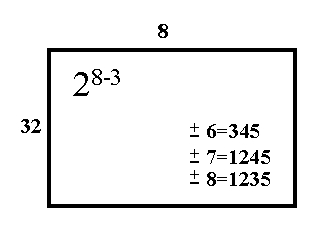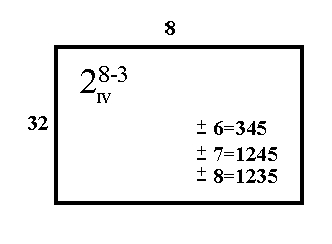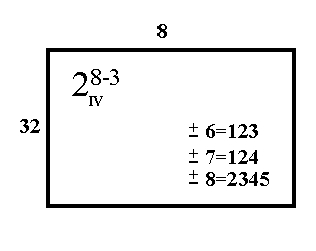5.3. Choosing and running an experimental design
5.3.3. How do you select an experimental design?
5.3.3.2. Fractional factorial designs
5.3.3.2.4. |
Design resolution: A measure of merit |
"Defining relation "for a factorial design
Definition of "Resolution"
Notation for resolution (roman numerals)
Resolution and confounding
FIGURE 3.6 Specifications for a 28-3 Design

(1) Write down a full factorial for 8-3 = 5 factors; that is,
a 25 full factorial design. Such a design has 25
= 32 rows.
(2) Add a sixth column to the design table for factor 6, using
6 = 345 (or 6 = -345) to manufacture it (i.e. using the column multiplication
we discussed above).
(3) Do likewise for factor 7 and for factor 8, using the appropriate
generating relations given in Figure 3.6.
We note further that the generating relations, written in ‘I = ...’ form, for the 28-3 is
This collection of generating relations for a factorial design is called a defining relation. There are three ‘words’ in the defining relation for the 28-3 design. The length of the shortest word in the defining relation is called the resolution of the design. Resolution describes the degree to which estimated main effects are aliased (or confounded) with estimated 2-level interactions, 3-level interactions, etc
The length of the shortest word in the defining relation for the 28-3 design is four. This is written in Roman numeral script, and sub-scripted as 2IV8-3. Note that the 23-1 design has one word: ‘I = ±123’ in its defining relation, and so has resolution three; that is, we may write 2III3-1.
Now Figure 3.6 may be completed by writing it as:
FIGURE 3.7 Specifications for a 28-3, Showing Resolution
‘IV’

Similarly, in a resolution IV design, main effects are confounded with at worst three-factor interactions. We can see, in Figure 3.7, that 6=345. We also see that 36=45, 34=56, etc. (i.e. two-factor interactions are confounded with certain other two-factor interactions) etc.; but we never see the likes of 2=13, or 5=34, (main effects confounded with two-factor interactions).
The complete confounding pattern, for confounding of up to two-factor interactions, arising from the design given in Figure 3.7 is
34 = 56 = 78
35 = 46
36 = 45
37 = 48
38 = 47
57 = 68
Note that we have deliberately left out reference to three-factor interactions, and higher than three-factor interactions, because as we have said they are assumed negligible. (This may be a wrong assumption in some rare instances).
If we are interested in estimating up to two of the two-factor interactions free of confounding with other two-factor interaction when running this design, we would assign those factors of interest to columns 1 or column 2. This type of consideration is often key in choosing and setting up a design.
This means that a resolution IV design is ‘better’ than a resolution III design because we have a less severe confounding pattern in the ‘IV’ than in the ‘III’ situation; higher order interactions are usually assumed to be much less significant than low-order interactions.
A higher resolution design for the same number of factors will, however, require more runs and so it is ‘worse’ than a lower-order design in that sense.
Similarly, a resolution V design, main effects would be confounded with at worst four-factor interactions, and two factor interactions would be confounded with certain three-factor interactions.
Example: The 28-3 design is of resolution IV, and requires 32 runs. The 28-2 design, also for eight factors, has resolution V, but requires 64 runs.
The identifying relation for a design is not necessarily unique. An alternative relation that will generate a 28-3 design is { I = ± 1236; I = ± 1247; I = ± 23458 }. Diagramatically, this is
FIGURE 3.8 Another Way of Generating the 28-3 Design

Commonly used design Resolutions
The meaning of the most prevalent resolution levels is as follows:
Resolution III Designs
Main effects are confounded or aliased with two-factor
interactions and two-factor interactions are aliased with
each other.
Resolution IV Designs
No main effects are aliased with two-factor interactions ,
but two-factor interactions are aliased with each other.
Resolution V Designs
No main effect or two-factor interaction is aliased with any

